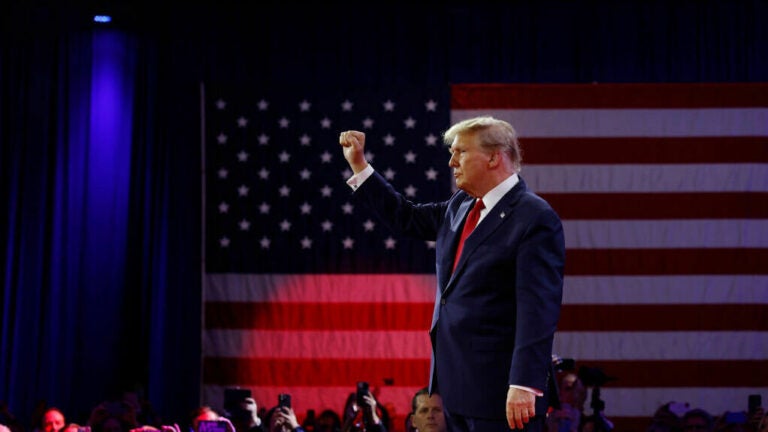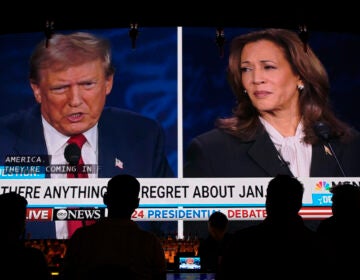4 things to know about Super Tuesday, including that winning it is crucial

Former President Donald Trump is pictured at the Conservative Political Action Conference on Feb. 24 in National Harbor, Md. This upcoming Tuesday will be a major voting day in the Republican primary. (Anna Moneymaker/Getty Images)
Former President Donald Trump looks now to be the inevitable nominee of the Republican Party.
He has won each of the first six nominating contests by double-digits. His lone major opponent in the race, Nikki Haley, says she is continuing on (for now), but she has yet to win in any state and trails Trump 122-24 in delegates.
That could balloon to a deficit in the hundreds by Wednesday morning if Haley can’t win a majority of the 15 states voting Tuesday, because of how delegates will be awarded.
Tuesday is Super Tuesday, the largest and most expansive primary day of the election season. More than a third of the delegates are up for grabs, and it has been determinative of nominees for decades, so a lot is on the line.
Here are four things to know ahead of Tuesday.
1. No Republican has become the party’s nominee since Super Tuesday has mattered without winning a majority of the states on that day.
Since 1988, the first time Republicans had a real, front-loaded Super Tuesday with a significant number of states voting on a single day, the candidate who won a majority of the states that day has gone on to win the nomination.
Here are the results from open years, ones without an incumbent president on the ballot, in GOP primaries. (Bolded names reflect the eventual nominee that year.)
1988: George H.W Bush 16, Pat Robertson 1
1996: Bob Dole 9-0
2000: George W. Bush 9, John McCain 4
2008: McCain 9, Mitt Romney 7, Mike Huckabee 5
2012: Romney 6, Rick Santorum 3, Newt Gingrich 1
2016: Donald Trump 7, Ted Cruz 3, Marco Rubio 1
It’s understandable that this would be the case. Super Tuesday is the closest thing to a national primary.
This year, for example, 874 delegates are at stake, or 36% of the total available.
2. The states mostly allocate their delegates by winner-take-all — and that method could create an insurmountable lead for a front-runner.
Sometimes delegates are awarded proportionally, sometimes it’s by congressional district, sometimes it’s a mix of both and sometimes the winner gets all of them.
The winner-take-all method is something Republicans use because they want to get the primary over with, so the base of the party can consolidate around one candidate and avoid acrimonious convention fights. Democrats, looking to be more egalitarian, prefer to award delegates proportionally, but that can prolong primary fights.
Super Tuesday is the first day this cycle when Republican states are mostly awarding delegates essentially winner-take-all. In short, for the most part, if a candidate gets more than 50% of the votes, they get all the delegates. In a two-person race, like the current situation, that means the winner is getting all the delegates.
If one candidate sweeps most of the states, it would create a largely insurmountable lead for that front-runner. If Trump’s massive lead in national polls holds, that could very well be the case Tuesday night.
3. Trump has a huge advantage with core Republicans, and there aren’t likely enough independents in Super Tuesday states to give Haley a path.
Trump has won by sweeping margins with primary voters who have identified as Republicans. Haley, on the other hand, has done well with independents who have voted in Republican primaries.
But, if history is any guide, there don’t appear to be enough Republican-leaning independent voters in Super Tuesday states for Haley to make a real dent.
Nine of this year’s Super Tuesday states had exit polls conducted in their 2016 primaries. Of those, just two had electorates with less than 60% who identified as Republicans – Vermont and Massachusetts. They account for just 57 delegates, or 7% of what’s up for grabs Tuesday.
Even if you add in states with moderate overall populations that didn’t have exit polls in 2016, like California, Colorado and Maine, it still would be far from enough – only 283 delegates, or about a third of Tuesday’s tranche. Give Haley all of those, and she would still wind up almost 700 delegates in the hole.
And even giving Haley those five is a stretch. Consider: Only 50% of New Hampshire primary voters this year identified as Republicans – and Haley still lost by 11 points in that contest.
To drive home the point, in South Carolina, her home state, she won independents by 19 points, according to exit polls, but still lost the primary by 20 points.
To state the obvious: A candidate has to be able to win Republicans to win the Republican nomination.
4. Haley and groups supporting her have spent almost $100 million, and she hasn’t yet won a state. It shows just how much the base is with Trump.
More than $300 million ($304 million) has now been spent to try to win the GOP nomination, according to an analysis by NPR of data provided by the ad-tracking firm AdImpact, which NPR has partnered with through the 2024 election.
Nearly a third of the money spent on ads so far has come from Haley and groups supporting her — almost $100 million.
Most of the campaigns went for broke trying to catch lightning in a bottle in the first two states, Iowa and New Hampshire — and when they didn’t, they dropped out.
But Haley and the groups supporting her have been flush with cash, and that’s why she’s been able to continue on. They made a full-court press in South Carolina. After the New Hampshire primary, $16 million was spent on ads in South Carolina with $15 million coming from team Haley.
It made little difference — and failed to derail Trump.




